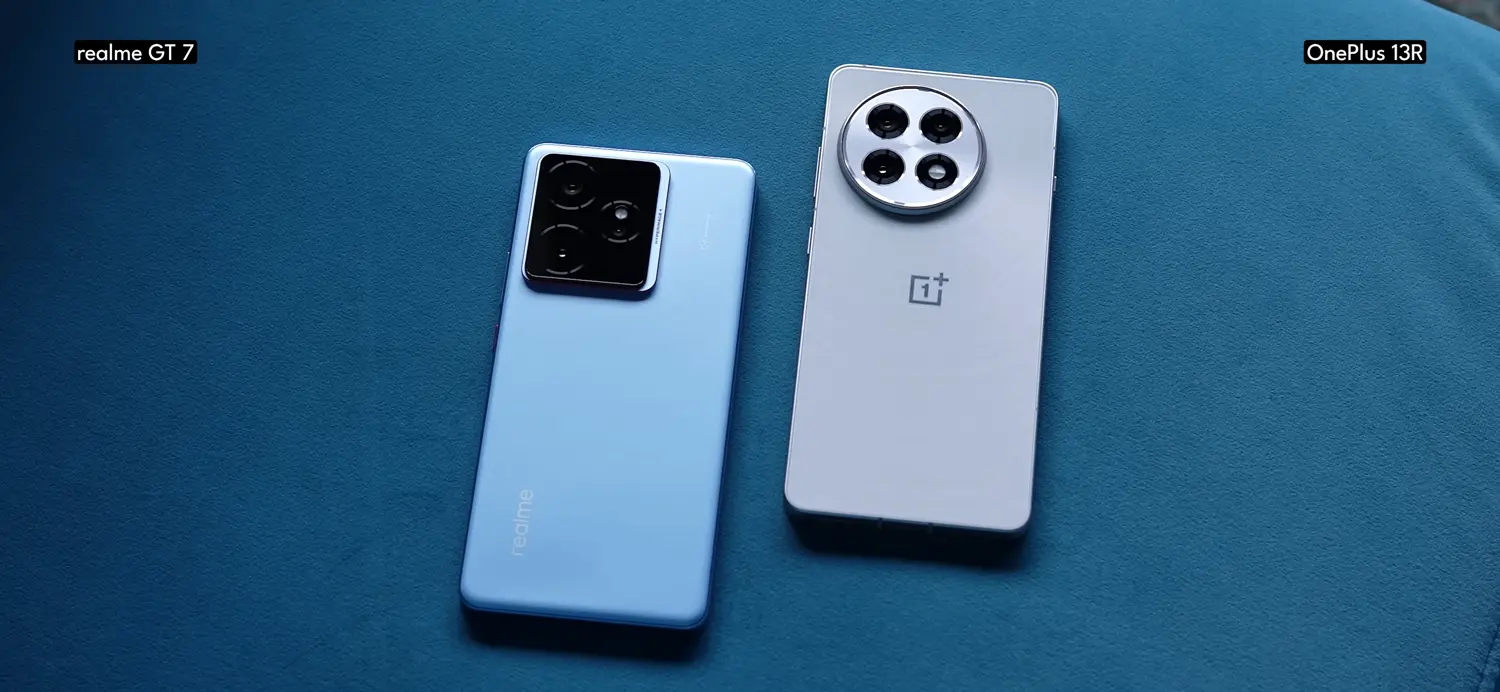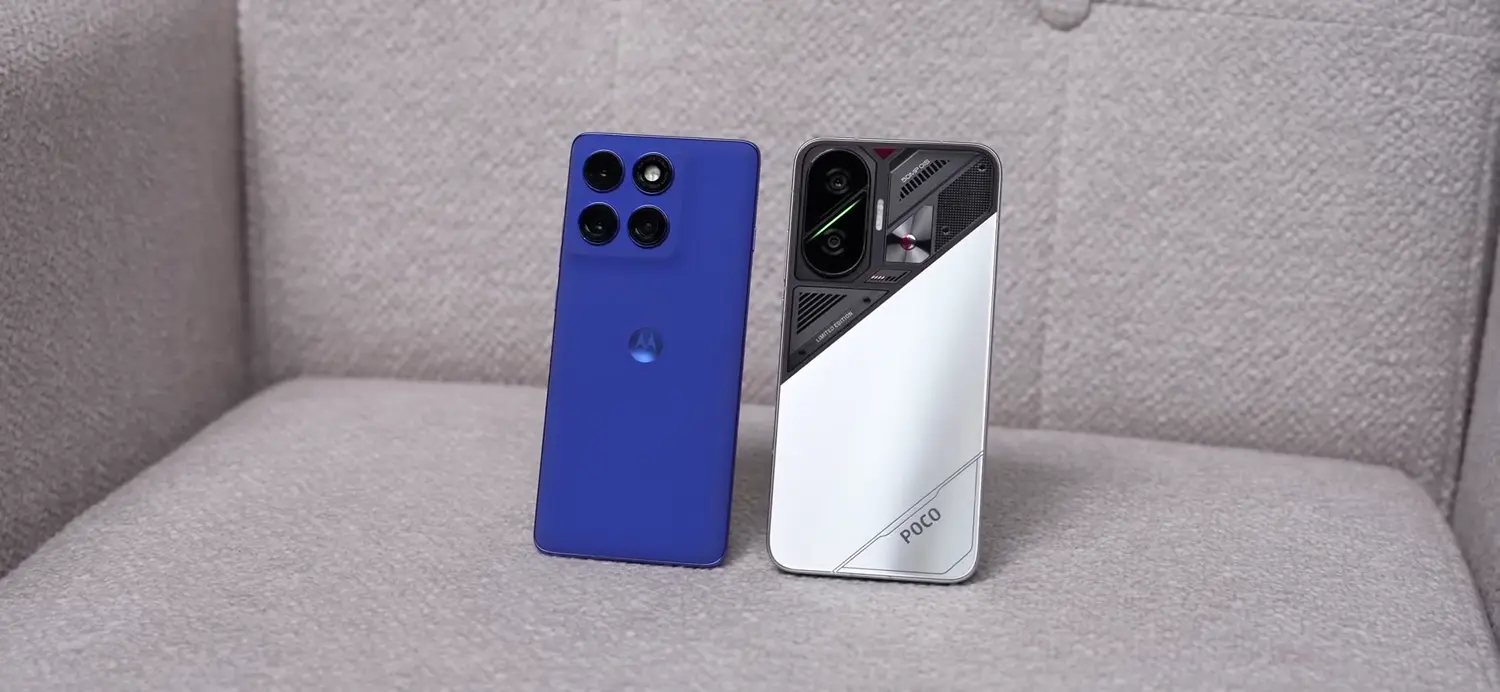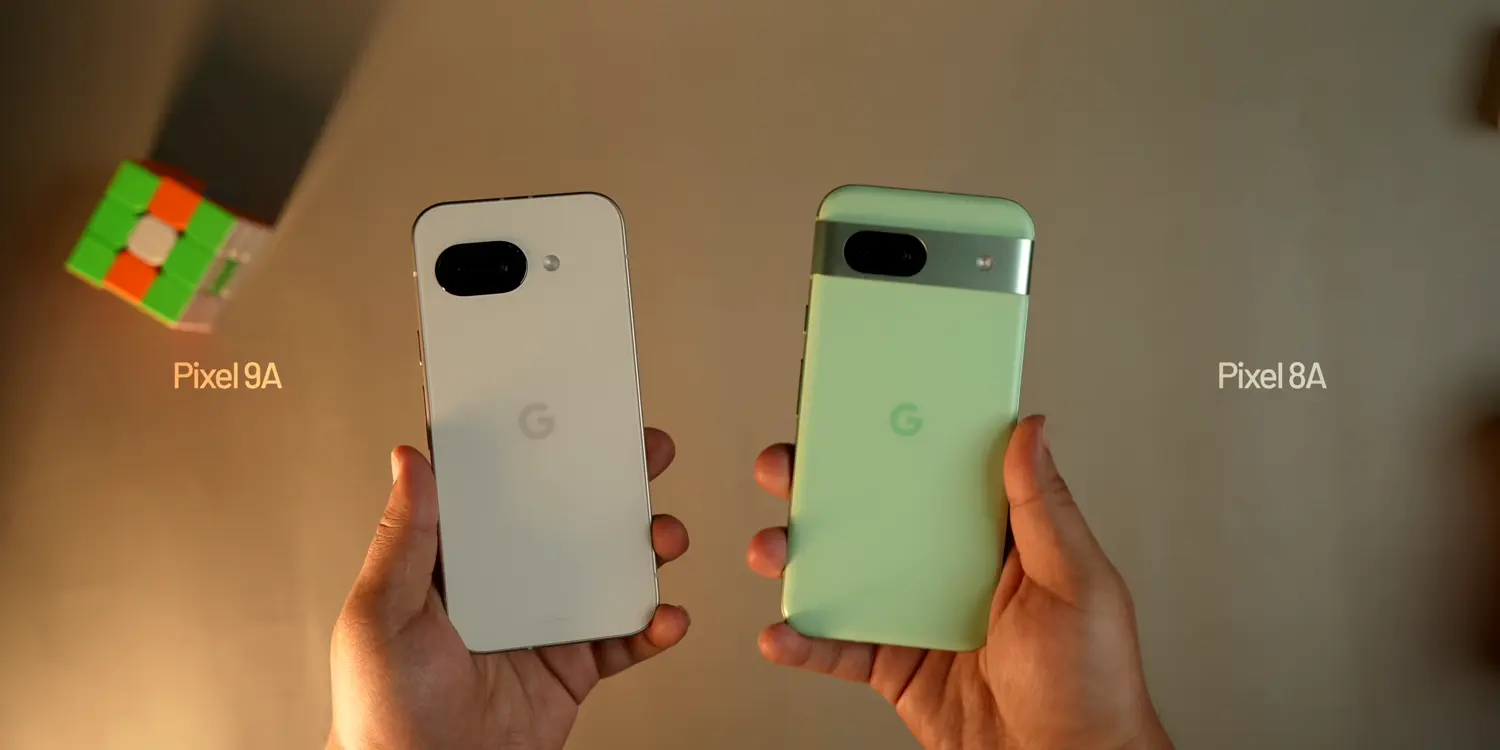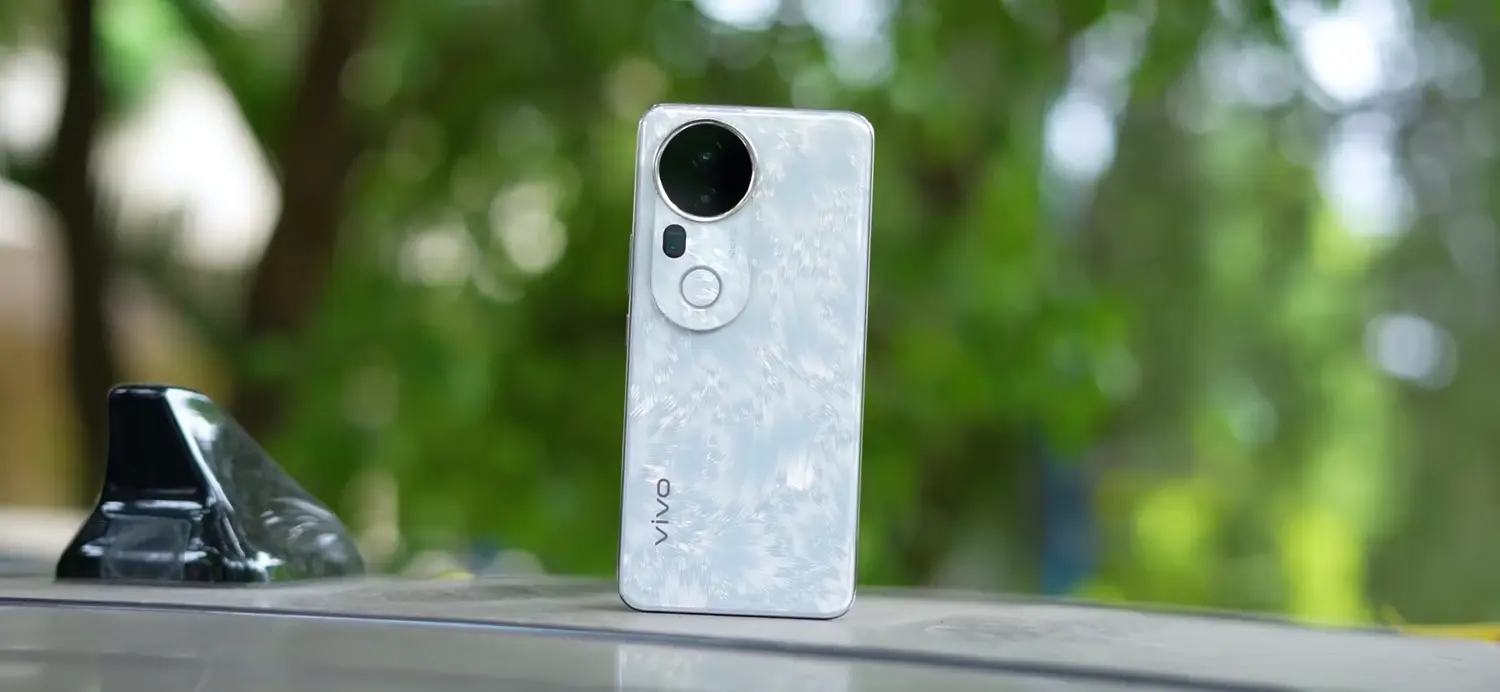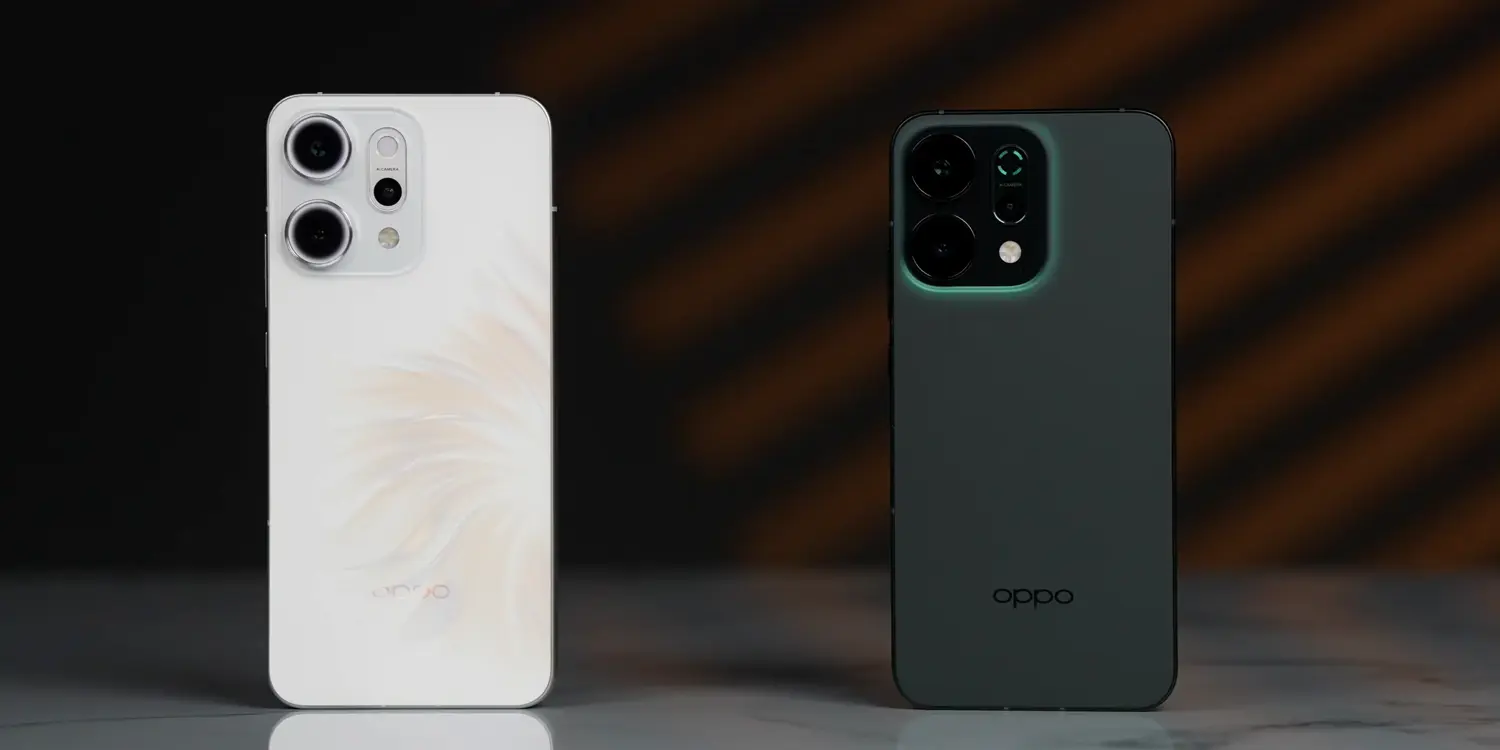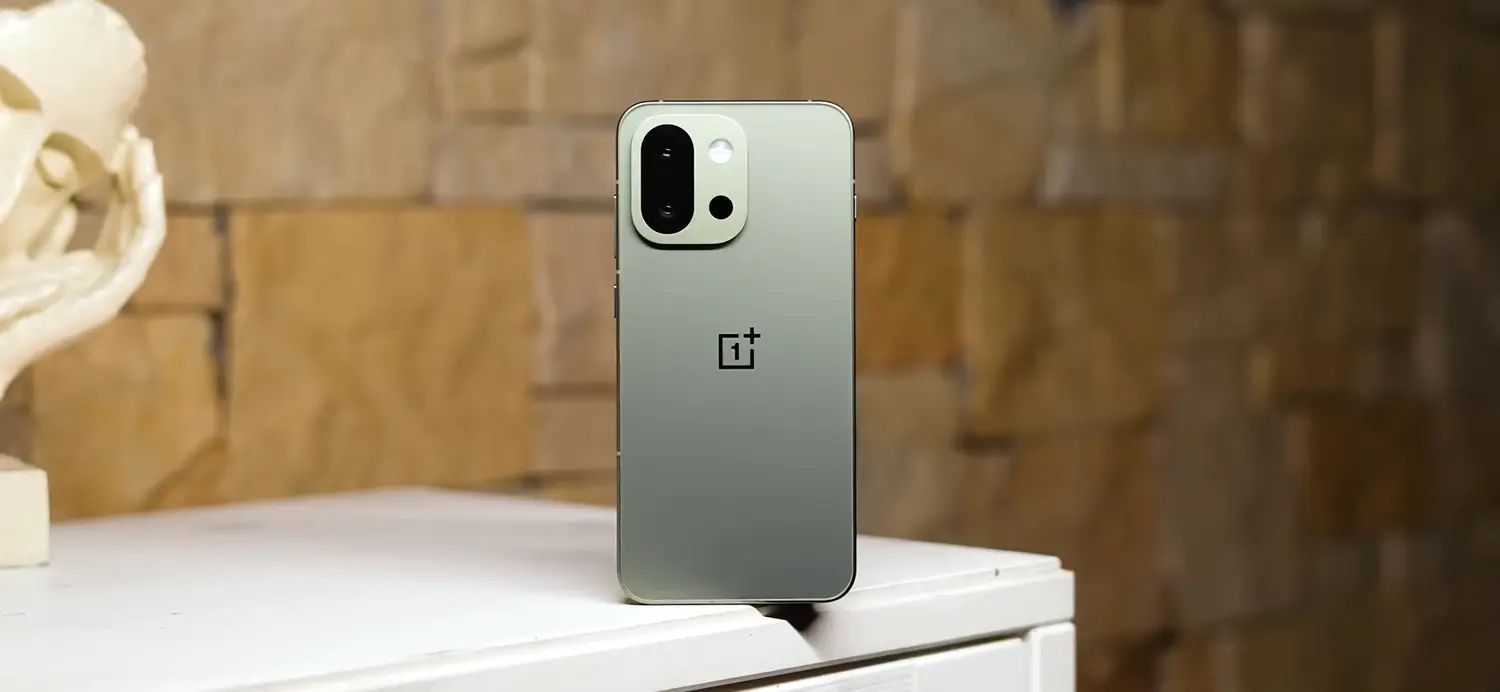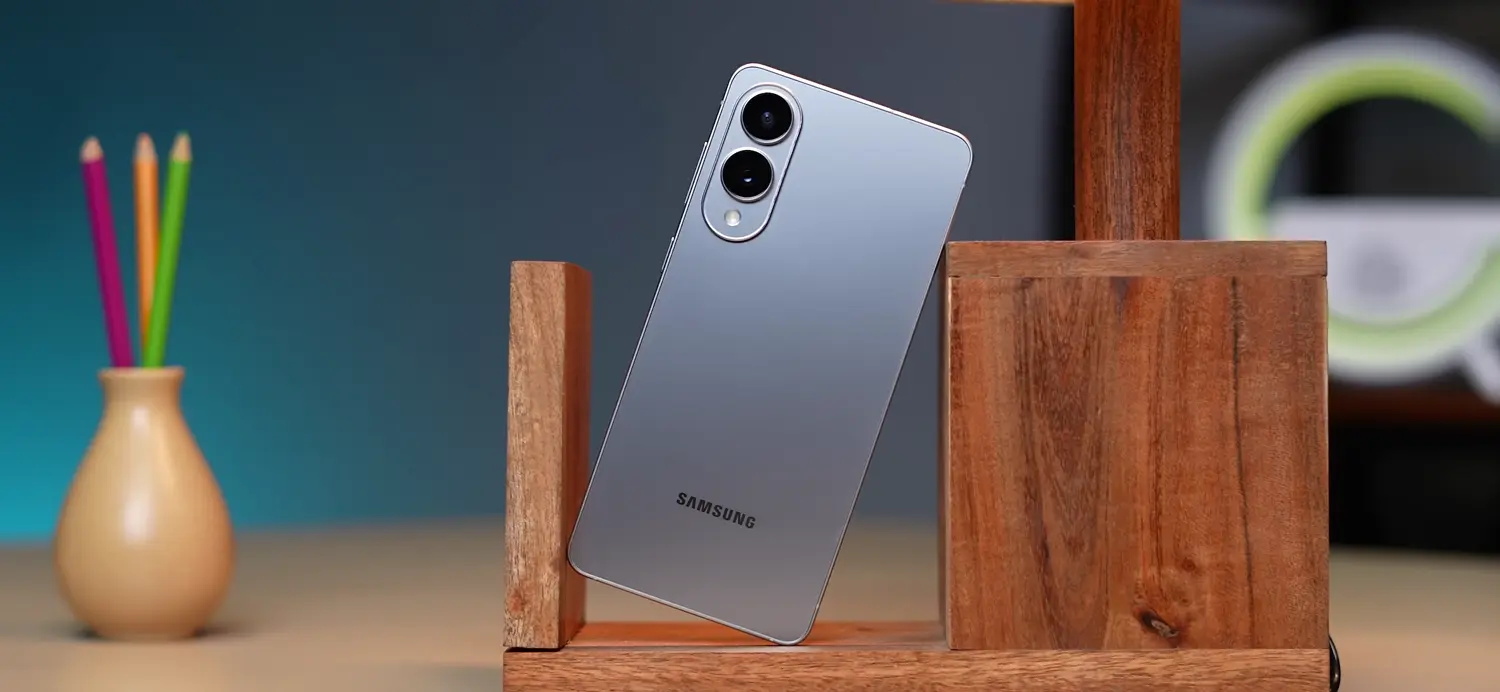The smartphone market in India is buzzing with options, and two devices that have caught everyone’s attention are the Motorola Edge 60 Pro and the Vivo V50. Both phones are priced under ₹35,000 and offer impressive features, making them strong contenders in the mid-range segment. If you’re wondering which one to buy, this detailed comparison will help you decide. We’ll look at their design, display, performance, cameras, battery, software, and AI features to see which phone offers better value for your money. By the end, you’ll have a clear idea of whether the Motorola Edge 60 Pro or the Vivo V50 is the right choice for you.
Design and Build Quality
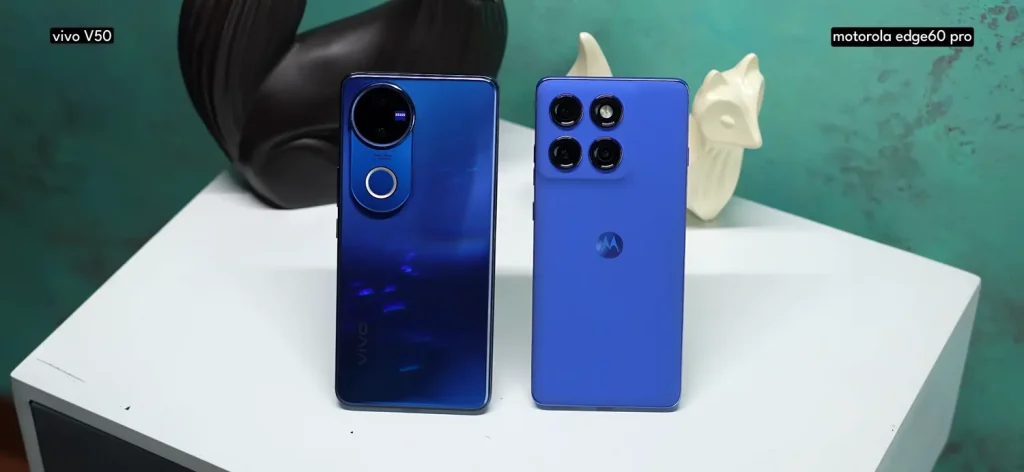
Both the Motorola Edge 60 Pro and Vivo V50 feel premium despite their mid-range price tags. The Motorola Edge 60 Pro sports a vegan leather back, which gives it a unique texture and a comfortable grip. The Vivo V50, on the other hand, uses a glass back, which looks sleek but can be a fingerprint magnet. Both phones have a plastic frame, which is common in this price range, but they still feel sturdy and well-built.
The Motorola Edge 60 Pro is slightly thicker but lighter than the Vivo V50, making it easier to hold for long periods. Both phones have slim bezels, but their curved displays make them a bit slippery, so you’ll need to be careful to avoid accidental drops. A big plus for both is their IP68 and IP69 dust and water resistance ratings, which offer peace of mind in a country like India where rain is common. However, Motorola goes a step further with MIL-STD-810H certification, meaning it’s tested for durability against drops, shocks, and extreme conditions. This makes the Motorola a bit more rugged.
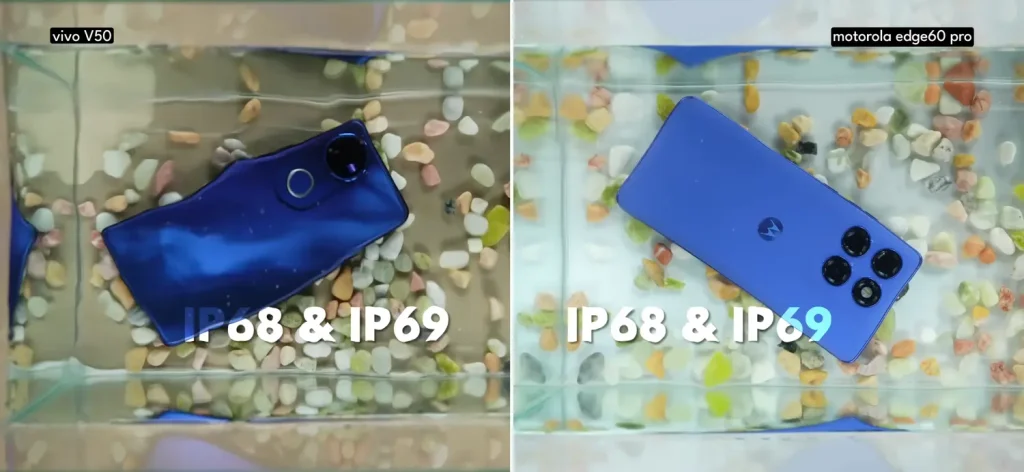
For display protection, the Motorola Edge 60 Pro uses Corning Gorilla Glass 7i, while the Vivo V50 has Vivo’s custom Diamond Glass protection. Both are effective, but Gorilla Glass is a more recognized standard. The Motorola’s vegan leather back, especially in its stunning Dazzling Blue color, feels fresh and stylish, while the Vivo’s glass back in colors like Rose Red or Titanium Grey looks elegant. It’s a matter of personal taste—vegan leather for a unique feel or glass for a classic premium look.
Display Quality
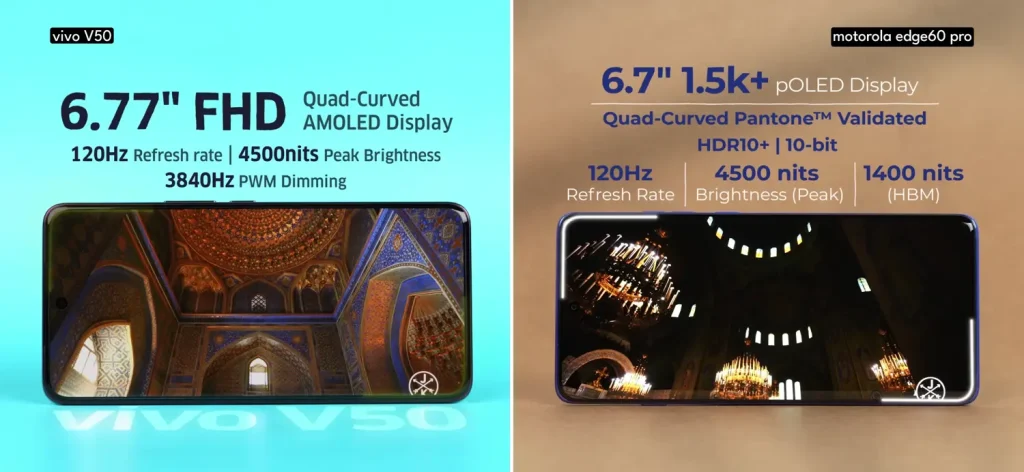
The display is one area where the Motorola Edge 60 Pro stands out. Both phones use OLED panels with a 120Hz refresh rate and HDR10+ support, ensuring smooth scrolling and vibrant visuals. However, the Motorola Edge 60 Pro has a higher resolution and smaller screen size, resulting in a sharper display with more pixels per inch (PPI). It also has slimmer bezels and a more pronounced curve, giving it a higher screen-to-body ratio and a more immersive look.
Both phones claim similar HDR peak brightness levels, but Motorola’s display is Pantone-validated for accurate colors and skin tones, making it ideal for watching YouTube videos or HDR content. In outdoor conditions, both displays perform similarly, but Motorola’s color tuning feels more flagship-like. The Vivo V50 has one advantage: it supports Netflix HDR, which the Motorola lacks, making it a better choice for streaming enthusiasts.
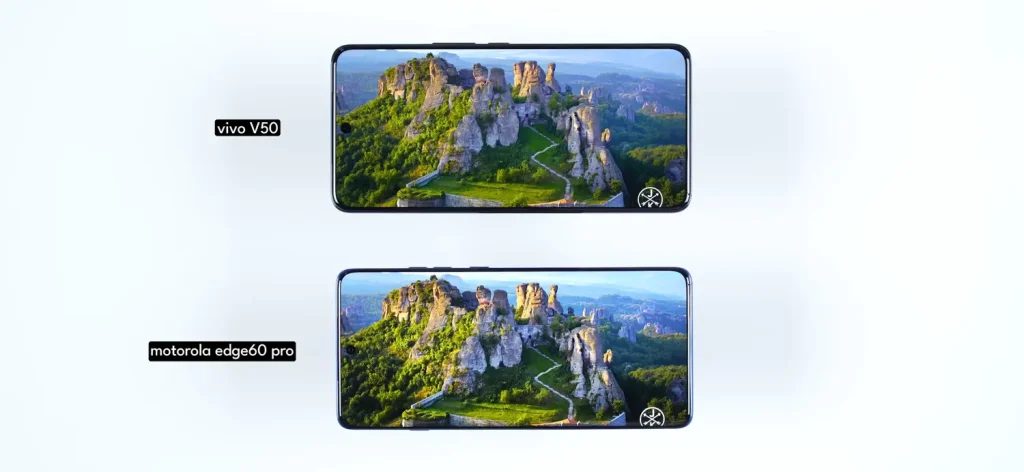
For audio, both phones offer stereo speakers, but the Motorola Edge 60 Pro has slightly better bass, enhancing the multimedia experience. It also supports high-res Bluetooth codecs like LDAC and aptX, compared to just LDAC on the Vivo V50. The Motorola’s haptic feedback and instantaneous touch sampling rate are also slightly better, making it more responsive for gaming and typing. However, the Vivo V50 has a higher PWM dimming rate, which reduces flicker and is easier on the eyes during extended use. Both phones have fast in-display fingerprint scanners, so no issues there.
Overall, the Motorola Edge 60 Pro wins in display quality and multimedia experience due to its sharper screen, better color accuracy, and superior audio.
Performance and Gaming
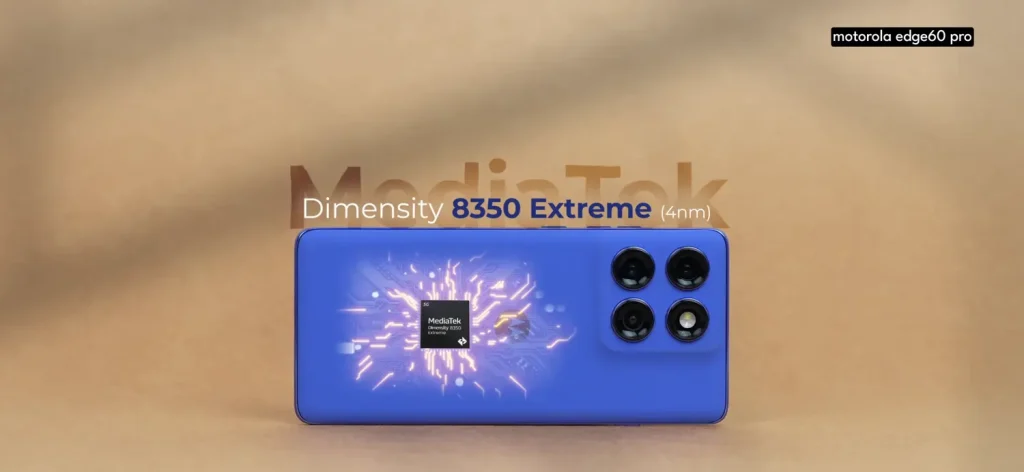
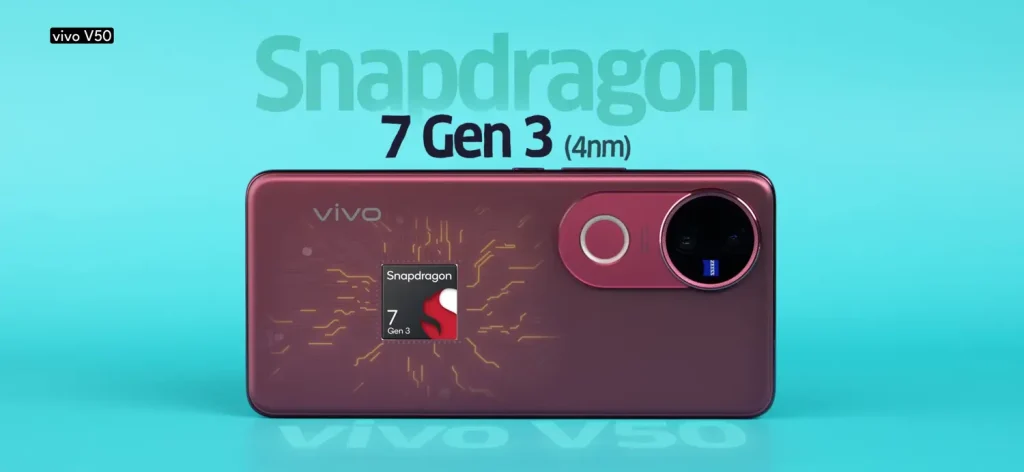
Performance is where the Motorola Edge 60 Pro pulls ahead significantly. It is powered by the MediaTek Dimensity 8350 Extreme chipset, a near-flagship processor that delivers excellent performance. The Vivo V50, however, uses the Snapdragon 7 Gen 3, a mid-range chipset that feels underpowered for a phone priced under ₹35,000 in 2025. The Motorola also uses faster LPDDR5X RAM and UFS 4.0 storage, compared to the Vivo’s LPDDR4X RAM and UFS 2.2 storage. This means apps open faster, multitasking is smoother, and storage benchmarks show higher read/write speeds on the Motorola.
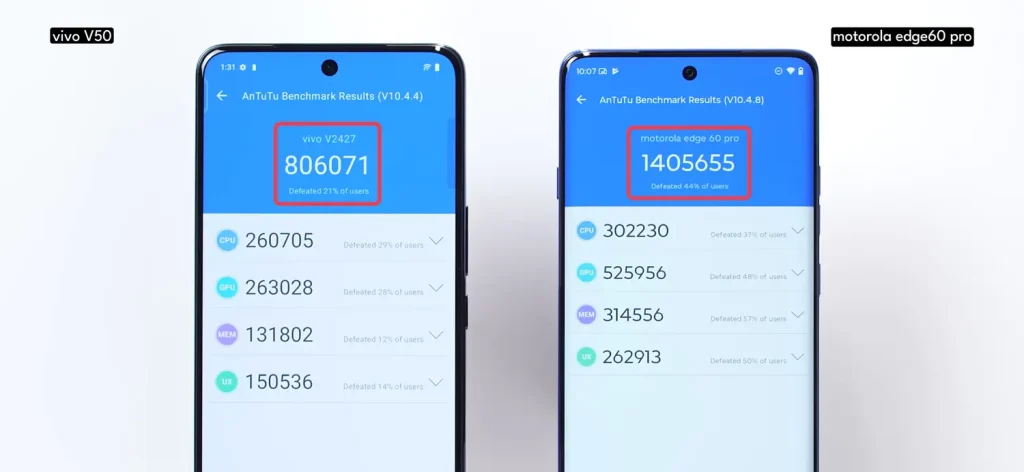
In benchmarks like Geekbench and AnTuTu, the Motorola Edge 60 Pro outperforms the Vivo V50 by a wide margin. For gaming, the Motorola’s GPU supports ray tracing and delivers higher frame rates in demanding games like Genshin Impact, with temperatures staying below 40°C. The Vivo V50, while stable and less prone to throttling, gets warmer and struggles to maintain high frame rates in heavy games. Both phones are capped at 60 fps in BGMI, but the Motorola supports 120 fps in COD, giving it an edge for gamers.
The Vivo V50’s Snapdragon 7 Gen 3 is well-optimized and doesn’t throttle, but its mid-range performance limits its gaming potential. If you’re a casual user, the Vivo V50 is fine, but for gaming or heavy multitasking, the Motorola Edge 60 Pro is the clear winner.
Camera Performance
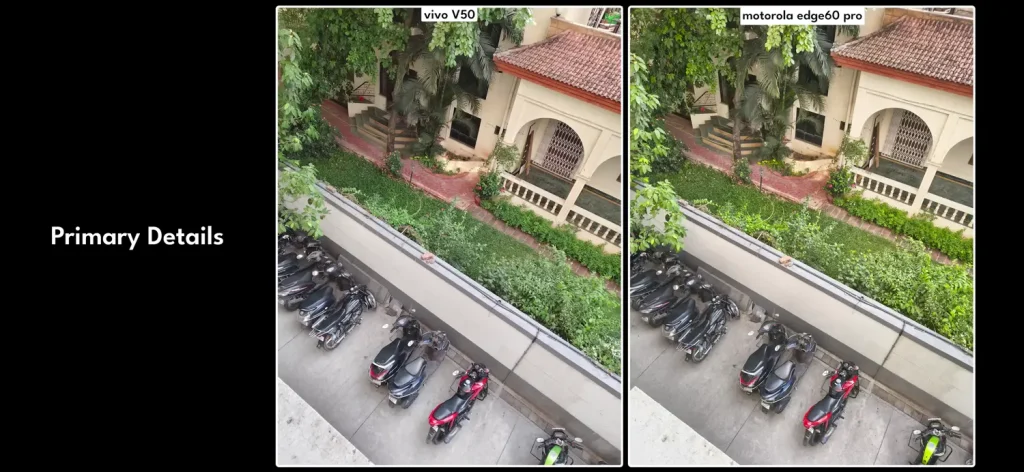
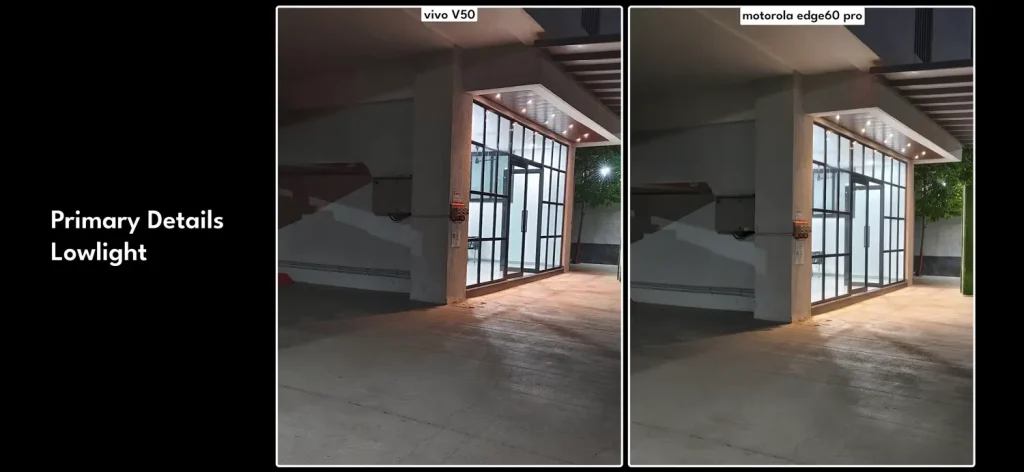
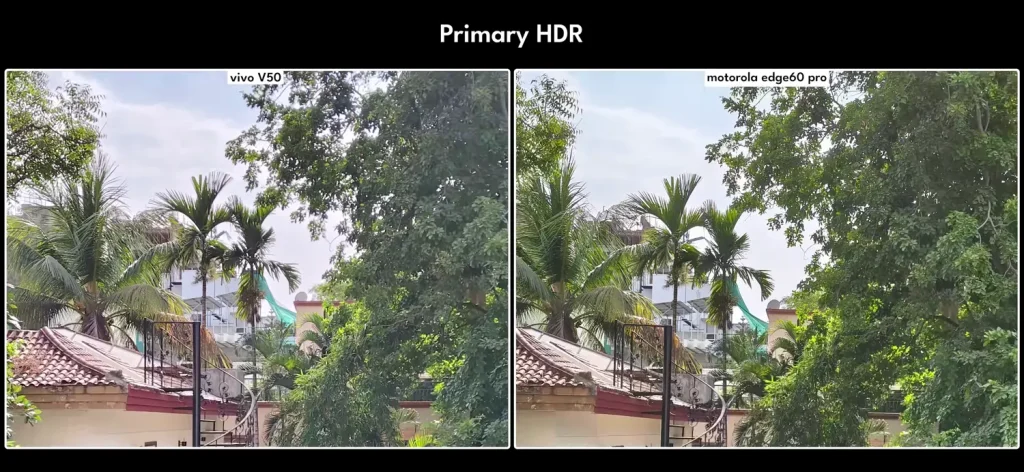
The Vivo V50 is marketed as a camera-focused phone, but the Motorola Edge 60 Pro gives it tough competition. Both phones have a 50MP primary camera and a 50MP ultra-wide camera with macro capabilities. However, the Motorola Edge 60 Pro adds a 10MP 3x telephoto lens, which the Vivo V50 lacks, making the Motorola more versatile for zoom shots. Both phones also have 50MP selfie cameras.
In daylight, the Motorola Edge 60 Pro captures sharper images with better detail retention, even at 100% crop. The Vivo V50’s photos are slightly oversharpened, which can look artificial. At 2x and 3x zoom, the Motorola’s telephoto lens delivers superior results, while the Vivo relies on digital cropping, which isn’t as good. In low light, the Motorola again performs better, with clearer details and less noise across all lenses. The ultra-wide cameras are comparable, but the Motorola has a slight edge in low-light conditions.
For selfies, the Vivo V50 produces warmer, more natural tones, especially in low light, and its portrait mode offers better edge detection and bokeh. However, the Motorola’s selfies are sharper against backlit conditions. For video, both phones support 4K 30fps recording, but the Motorola offers better stabilization and cleaner footage across all lenses, including the telephoto. Motorola’s AI-powered action shots also freeze motion effectively without losing details.
While the Vivo V50 excels in portrait photography, the Motorola Edge 60 Pro’s telephoto lens and better overall tuning make it the stronger camera phone for most scenarios.
Battery and Charging

Both phones come with a 6,000mAh silicon-carbon battery and support 90W fast charging, which is impressive for the price. You can expect 9-10 hours of screen-on time, even with heavy use, making both excellent for all-day usage. The Motorola Edge 60 Pro has an advantage with 15W wireless charging, a rare feature in this segment. Both phones charge fully in about 40-45 minutes, so there’s no significant difference in wired charging speed.
Software and AI Features
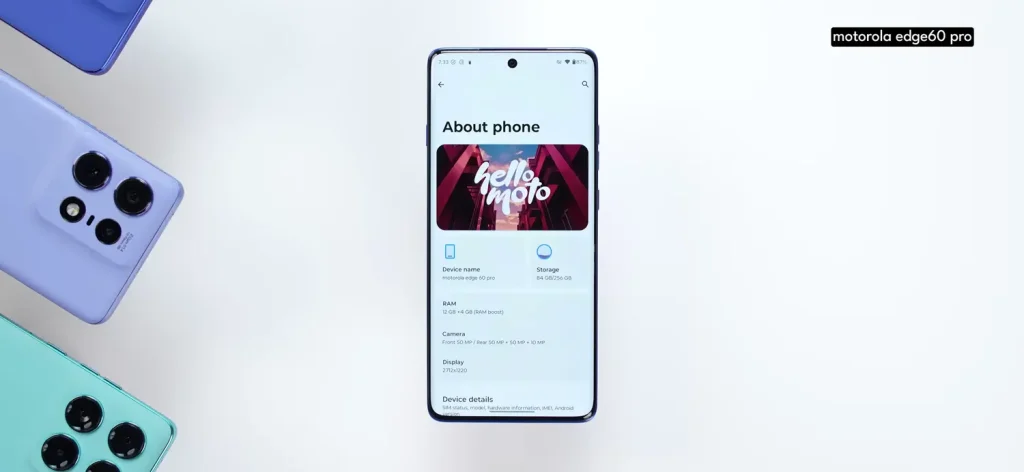
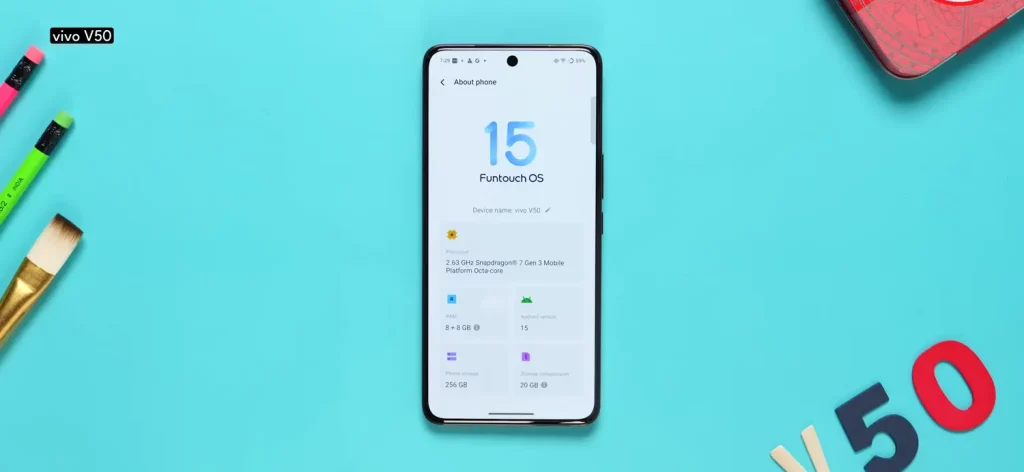
Both phones run Android 15, with Motorola using its Hello UI and Vivo using Funtouch OS 15. Both promise 3 years of OS updates and 4 years of security updates, which is great for longevity. However, both come with some bloatware, though you can uninstall most of it.
Motorola’s Hello UI feels cleaner and more intuitive, and its AI features, powered by Plexity and Microsoft Copilot, are a highlight. The dedicated Moto AI button (non-remappable) opens features like Update Me (notification summaries), AI Image Studio (image/sticker generation), Sketch to Image, Style Sync, and Remember This (voice notes with transcription). The Playlist Studio creates music playlists based on prompts, though it requires an Amazon Prime subscription. Moto AI’s contextual “Next Move” feature suggests actions based on what’s on your screen, like creating a playlist for a concert you’re browsing. These features feel innovative and practical for daily use.
The Vivo V50 also has AI features like AI Eraser, AI Photo Enhance, Instant Cutout, Circle to Search, and AI call translation, which are useful. However, Motorola offers all these features plus more, making its AI experience more comprehensive. If you value AI-driven functionality, the Motorola Edge 60 Pro is the better choice.
Connectivity and Extras
Both phones support 5G with ample band coverage, working well with Jio and Airtel networks. The Motorola Edge 60 Pro has Wi-Fi 6 and NFC, which the Vivo V50 lacks, giving Motorola an edge for faster Wi-Fi and contactless payments.
Price and Value for Money
The Vivo V50 starts at ₹34,978 for the 8GB RAM + 256GB storage variant, while the Motorola Edge 60 Pro is priced at ₹29,999 for the same configuration, making it significantly cheaper. Considering its superior performance, display, cameras, and AI features, the Motorola Edge 60 Pro offers better value for money.
Specification Table
| Feature | Motorola Edge 60 Pro | Vivo V50 |
|---|---|---|
| Price | ₹29,999 (8GB + 256GB) | ₹34,978 (8GB + 256GB) |
| Release Date | April 30, 2025 | February 17, 2025 |
| Operating System | Android 15 (Hello UI) | Android 15 (Funtouch OS 15) |
| Chipset | MediaTek Dimensity 8350 Extreme | Qualcomm Snapdragon 7 Gen 3 |
| RAM | 8GB (LPDDR5X) | 8GB (LPDDR4X) |
| Storage | 256GB (UFS 4.0) | 256GB (UFS 2.2) |
| Display | OLED, 120Hz, HDR10+ | OLED, 120Hz, HDR10+ |
| Display Protection | Corning Gorilla Glass 7i | Diamond Glass |
| Rear Cameras | 50MP (Main), 50MP (Ultra-wide), 10MP (3x Telephoto) | 50MP (Main), 50MP (Ultra-wide) |
| Front Camera | 50MP | 50MP |
| Battery | 6,000mAh, 90W wired, 15W wireless | 6,000mAh, 90W wired |
| Durability | IP68, IP69, MIL-STD-810H | IP68, IP69 |
| Connectivity | 5G, Wi-Fi 6, NFC | 5G, Wi-Fi 5 |
| Weight | Lighter | Heavier |
| Build | Vegan Leather, Plastic Frame | Glass, Plastic Frame |
Should You Buy the Motorola Edge 60 Pro or Vivo V50?
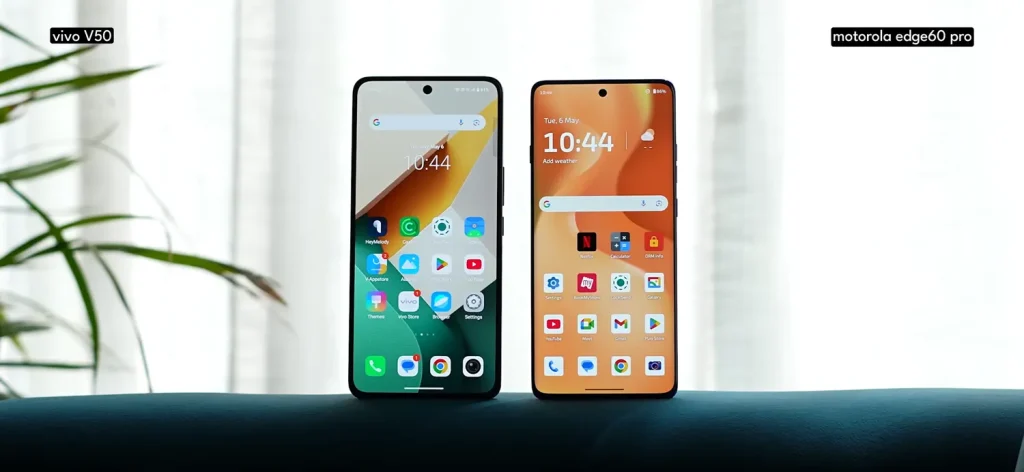
The Motorola Edge 60 Pro is the better choice for most users under ₹35,000. Its powerful Dimensity 8350 Extreme chipset, faster RAM and storage, sharper display, versatile cameras with a telephoto lens, and innovative AI features make it a standout. The addition of wireless charging, Wi-Fi 6, NFC, and MIL-STD-810H certification further sweetens the deal. At ₹29,999, it’s also more affordable than the Vivo V50, offering better value for money.
The Vivo V50 is still a solid option, especially if you prioritize portrait photography, Netflix HDR support, or a glass-back design. Its Snapdragon 7 Gen 3 is stable and sufficient for casual users, and its AI features are useful. However, it falls short in performance, camera versatility, and connectivity compared to the Motorola.
If you’re a gamer, power user, or someone who wants a well-rounded phone with cutting-edge AI, the Motorola Edge 60 Pro is the clear winner. For photography enthusiasts who focus on portraits or streaming, the Vivo V50 is worth considering, but it’s hard to ignore the Motorola’s overall superiority.
Is It Worth It?
Both phones are worth their price, but the Motorola Edge 60 Pro offers more for less. Its combination of performance, cameras, and AI features makes it feel like a flagship in a mid-range body. The Vivo V50 is a good camera phone, but its mid-range chipset and lack of features like NFC and wireless charging make it less compelling. If you’re looking for the best phone under ₹35,000 in 2025, the Motorola Edge 60 Pro is the one to buy.

